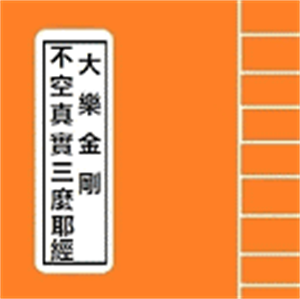
大乐金刚不空真实三么耶经
三藏沙门不空奉 诏译
大乐金刚不空真实三么耶经
开府仪同三司特进试鸿胪卿肃国公食邑三千户赐紫赠司空谥大正监号大广智大兴善寺三藏沙门不空奉 诏译
般若波罗蜜多理趣品
如是我闻:
一时薄伽梵,成就殊胜一切如来金刚加持三么耶智,已得一切如来灌顶宝冠,为三界主,已证一切如来一切智智,瑜伽自在,能作一切如来一切印平等种种事业,于无尽无余一切众生界,一切意愿作业皆悉圆满,常恒三世一切时,身语意业金刚大毗卢遮那如来。在于欲界他化自在天王宫中,一切如来常所游处,吉祥称叹大摩尼殿,种种间错铃铎缯幡微风摇击,珠鬘璎珞半满月等而为庄严。与八十俱胝菩萨众俱,所谓:金刚手菩萨摩诃萨、观自在菩萨摩诃萨、虚空藏菩萨摩诃萨、金刚拳菩萨摩诃萨、文殊师利菩萨摩诃萨、才发心转法轮菩萨摩诃萨、虚空库菩萨摩诃萨、摧一切魔菩萨摩诃萨。与如是等大菩萨众,恭敬围绕而为说法。初中后善,文义巧妙,纯一圆满清净洁白,说一切法清净句门。所谓:「妙适清净句是菩萨位;欲箭清净句是菩萨位;触清净句是菩萨位;爱缚清净句是菩萨位;一切自在主清净句是菩萨位;见清净句是菩萨位;适悦清净句是菩萨位;爱清净句是菩萨位;慢清净句是菩萨位;庄严清净句是菩萨位;意滋泽清净句是菩萨位;光明清净句是菩萨位;身乐清净句是菩萨位;色清净句是菩萨位;声清净句是菩萨位;香清净句是菩萨位;味清净句是菩萨位。何以故?一切法自性清净故,般若波罗蜜多清净。金刚手!若有闻此清净出生句般若理趣,乃至菩提道场,一切盖障及烦恼障、法障、业障,设广积集,必不堕于地狱等趣。设作重罪,销灭不难。若能受持,日日读诵作意思惟,即于现生证一切法平等金刚三摩地,于一切法皆得自在,受于无量适悦欢喜,以十六大菩萨生,获得如来及执金刚位。」
时薄伽梵,一切如来大乘现证三么耶一切曼荼罗持金刚胜萨埵,于三界中调伏无余,一切义成就,金刚手菩萨摩诃萨,为欲显明此义故,熈怡微笑,左手作金刚慢印,右手搊掷本初大金刚,作勇进势,说大乐金刚不空三么耶心:
「吽(引)」
尔时薄伽梵毗卢遮那如来,复说此一切如来寂静法性现等觉出生般若理趣。所谓:「金刚平等现等觉,以大菩提金刚坚固故;义平等现等觉,以大菩提一义利故;法平等现等觉,以大菩提自性清净故;一切业平等现等觉,以大菩提一切分别无分别性故。金刚手!若有闻此四出生法,读诵受持,设使现行无量重罪,必能超越一切恶趣,乃至当坐菩提道场,速能剋证无上正觉。」
时薄伽梵如是说已,欲重显明此义故,熈怡微笑,持智拳印,说一切法自性平等心:
「恶(引、重呼)」
时调伏难调释迦牟尼如来,复说一切法平等最胜出生般若理趣。所谓:「欲无戏论性故,瞋无戏论性;瞋无戏论性故,痴无戏论性;痴无戏论性故,一切法无戏论性;一切法无戏论性故,应知般若波罗蜜多无戏论性。金刚手!若有闻此理趣,受持读诵,设害三界一切有情,不堕恶趣,为调伏故,疾证无上正等菩提。」
时金刚手大菩萨,欲重显明此义故,持降三世印,以莲花面微笑而怒颦眉勐视,利牙出现,住降伏立相,说此金刚吽迦[口*逻]心:
「吽(短)」
时薄伽梵得自性清净法性如来,复说一切法平等观自在智印出生般若理趣。所谓:「世间一切欲清净故,即一切瞋清净;世间一切垢清净故,即一切罪清净;世间一切法清净故,即一切有情清净;世间一切智智清净故,即般若波罗蜜多清净。金刚手!若有闻此理趣,受持读诵作意思惟,设住诸欲犹如莲花,不为客尘诸垢所染,疾证无上正等菩提。」
时薄伽梵观自在大菩萨,欲重显明此义故,熈怡微笑,作开敷莲花势,观欲不染,说一切群生种种色心:
「纥唎(二合、引、入)」
时薄伽梵一切三界主如来,复说一切如来灌顶智藏般若理趣。所谓:「以灌顶施故,能得三界法王位;义利施故,得一切意愿满足;以法施故,得圆满一切法;资生施故,得身口意一切安乐。」
时虚空藏大菩萨,欲重显明此义故,熈怡微笑,以金刚宝鬘自系其首,说一切灌顶三么耶宝心:
「怛览(二合、引)」
时薄伽梵得一切如来智印如来,复说一切如来智印加持般若理趣。所谓:「持一切如来身印,即为一切如来身;持一切如来语印,即得一切如来法;持一切如来心印,即证一切如来三摩地;持一切如来金刚印,即成就一切如来身口意业最胜悉地。金刚手!若有闻此理趣,受持读诵作意思惟,得一切自在、一切智智、一切事业、一切成就,得一切身口意金刚性、一切悉地,疾证无上正等菩提。」
时薄伽梵,为欲显明此义故,熈怡微笑,持金刚拳大三么耶印,说此一切坚固金刚印悉地三么耶自真心:
「噁」
时薄伽梵一切无戏论如来,复说转字轮般若理趣。所谓:「诸法空,与无自性相应故;诸法无相,与无相性相应故;诸法无愿,与无愿性相应故;诸法光明,般若波罗蜜多清净故。」
时文殊师利童真,欲重显明此义故,熈怡微笑,以自剑挥斫一切如来已,说此般若波罗蜜多最胜心:
「菴」
时薄伽梵一切如来入大轮如来,复说入大轮般若理趣。所谓:「入金刚平等,则入一切如来法轮;入义平等,则入大菩萨轮;入一切法平等,则入妙法轮;入一切业平等,则入一切事业轮。」
时才发心转法轮大菩萨,欲重显明此义故,熈怡微笑,转金刚轮说一切金刚三么耶心:
「吽」
时薄伽梵一切如来种种供养藏广大仪式如来,复说一切供养最胜出生般若理趣。所谓:「发菩提心,则为于诸如来广大供养;救济一切众生,则为于诸如来广大供养;受持妙典,则为于诸如来广大供养;于般若波罗蜜多,受持读诵,自书教他书,思惟修习,种种供养,则为于诸如来广大供养。」
时虚空库大菩萨,欲重显明此义故,熈怡微笑,说此一切事业不空三么耶一切金刚心:
「唵」
时薄伽梵能调持智拳如来,复说一切调伏智藏般若理趣。所谓:「一切有情平等故,忿怒平等;一切有情调伏故,忿怒调伏;一切有情法性故,忿怒法性;一切有情金刚性故,忿怒金刚性。何以故?一切有情调伏,则为菩提。」
时摧一切魔大菩萨,欲重显明此义故,熈怡微笑,以金刚药叉形,持金刚牙,恐怖一切如来已,说金刚忿怒大笑心:
「郝」
时薄伽梵一切平等建立如来,复说一切法三么耶最胜出生般若理趣。所谓:「一切平等性故,般若波罗蜜多平等性;一切义利性故,般若波罗蜜多义利性;一切法性故,般若波罗蜜多法性;一切事业性故,般若波罗蜜多事业性应知。」
时金刚手,入一切如来菩萨三么耶加持三摩地,说一切不空三么耶心:
「吽」
时薄伽梵如来,复说一切有情加持般若理趣。所谓:「一切有情如来藏,以普贤菩萨一切我故;一切有情金刚藏,以金刚藏灌顶故;一切有情妙法藏,能转一切语言故;一切有情羯磨藏,能作所作性相应故。」
时外金刚部,欲重显明此义故,作欢喜声,说金刚自在自真实心:
「怛[口*赖](二合)」
尔时诸母女天,顶礼佛足,献鈎召摄入能杀能成三么耶真实心:
「毗欲(二合)」
尔时末度迦罗天三兄弟等,亲礼佛足,献自心:
「娑嚩(二合)」
尔时四姊妹女天,献自心:
「[山*含]」
时薄伽梵无量无边究竟如来,为欲加持此教令究竟圆满故,复说平等金刚出生般若理趣。所谓:「般若波罗蜜多无量故,一切如来无量;般若波罗蜜多无边故,一切如来无边;一切法一性故,般若波罗蜜多一性;一切法究竟故,般若波罗蜜多究竟。金刚手!若有闻此理趣,受持读诵思惟其义,彼于佛菩萨行皆得究竟。」
时薄伽梵毗卢遮那得一切祕密法性无戏论如来,复说最胜无初中后大乐金刚不空三昧耶金刚法性般若理趣。所谓:「菩萨摩诃萨大欲最胜成就故,得大乐最胜成就;菩萨摩诃萨大乐最胜成就故,则得一切如来大菩提最胜成就;菩萨摩诃萨得一切如来大菩提最胜成就故,则得一切如来摧大力魔最胜成就;菩萨摩诃萨得一切如来摧大力魔最胜成就故,则得遍三界自在主成就;菩萨摩诃萨得遍三界自在主成就故,则得净除无余界一切有情住着流转,以大精进常处生死,救摄一切利益安乐,最胜究竟皆悉成就。何以故?
「菩萨胜慧者, 乃至尽生死,
恒作众生利, 而不趣涅槃。
般若及方便, 智度所加持,
诸法及诸有, 一切皆清净。
欲等调世间, 令得净除故,
有顶及恶趣, 调伏尽诸有。
如莲体本净, 不为垢所染,
诸欲性亦然, 不染利群生,
大欲得清净, 大安乐富饶,
三界得自在, 能作坚固利。
「金刚手!若有闻此本初般若理趣,日日晨朝或诵或听,彼获一切安乐悦意大乐金刚不空三昧耶究竟悉地,现世获得一切法自在悦乐,以十六大菩萨生,得于如来执金刚位。
「吽」
尔时一切如来,及持金刚菩萨摩诃萨等,皆来集会。欲令此法,不空无碍,速成就故,咸共称赞金刚手言:
「善哉,善哉!大萨埵! 善哉,善哉!大安乐!
善哉,善哉!摩诃衍! 善哉,善哉!大智慧!
善能演说此法教, 金刚修多罗加持,
持此最胜教王者, 一切诸魔不能坏,
得佛菩萨最胜位, 于诸悉地得不久。」
一切如来及菩萨, 共作如是胜说已,
为令持者速成就, 皆大欢喜信受行。
大乐金刚不空真实三么耶经